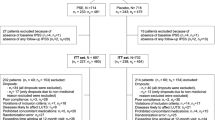Abstract
Permixon®, the lipidosterolic extract ofSerenoa repens, is widely used for the treatment of symptoms associated with benign prostatic hyperplasia (BPH). This open study assessed the efficacy and tolerability of Permixon 160 mg twice daily administered for 2 years. One hundred fifty-five men with clinically diagnosed BPH and complaints of prostatic symptoms were enrolled in the study. At 6, 12, 18, and 24 months, the International Prostate Symptom Score (I-PSS), quality of life, and sexual function score were recorded, and urodynamics and biologic values were measured. Adverse events were recorded every 3 months. I-PSS and quality of life improved significantly from baseline at each evaluation time point. At the end of the study and at each evaluation, maximum urinary flow also improved significantly. Prostate size decreased. Sexual function remained stable during the first year of treatment and significantly improved (P = .001) during the second year. Prostate-specific antigen was not affected, and no changes in plasma hormone levels were observed. Nine patients reported 10 adverse events, none related to treatment. Improvements in efficacy parameters began at 6 months and were maintained up to 24 months. These data demonstrate the long-term efficacy and tolerability of Permixon and support its use as a first-line medical therapy for uncomplicated symptomatic BPH.
Similar content being viewed by others
References
Berry SJ, Coffey DS, Walsh PC, Ewing L. The development of human benign prostatic hypertrophy with age.J Urol. 1984;132:474–479.
Holtgrewe HL. Current trends in management of men with lower urinary tract symptoms and benign prostatic hyperplasia.Urology. 1998;51(suppl 4):1–7.
Chacon A, Monga M. Medical management of benign prostatic hyperplasia.Geriatr Nephrol Urol. 1999;9:39–48.
Clifford GM, Farmer RD. Medical therapy for benign prostatic hyperplasia: a review of the literature.Eur Urol. 2000;38:2–19.
Djavan B, Marberger M. A meta-analysis of the efficacy and tolerability of α1-adrenoceptor antagonists in patients with lower urinary tract symptoms suggestive of benign prostatic obstruction.Eur Urol. 1999;36:1–13.
Carraro JC, Raynaud JP, Koch G, al. Comparison of phytotherapy (Permixon) with finasteride in the treatment of benign prostatic hyperplasia: a randomised international study of 1,098 patients.Prostate. 1996;29:231–240.
Lepor H, Williford WO, Barry MJ, et al. The efficacy of terazosin, finasteride or both in benign prostatic hyperplasia.N Engl J Med. 1996;338:533–539.
Buck AC. Phytotherapy for the prostate.Br J Urol. 1996;78:325–336.
Wilt TJ, Ishani A, Stark G, MacDonald R, Lau J, Mulrow C. Saw palmetto extracts for treatment of benign prostatic hyperplasia: a systematic review.JAMA. 1998;280:1604–1609.
Lowe FC, Fagelman E. Phytotherapy in the treatment of benign prostatic hyperplasia: an update.Urology. 1999;9:39–48.
Paubert-Braquet M, Cousse H, Raynaud JP, Mencia-Huerta JM, Braquet P. Effect of the lipidosterolic extract ofSerenoa repens and its major components on basic fibroblast growth factor-induced proliferation of cultures of human prostate biopsies.Eur Urol. 1998;33:340–347.
Iehlé C, Délos S, Guirou O, Tate R, Raynaud JP, Martin PM. Human prostatic steroid 5 alpha-reductase isoforms. A comparative study of selective inhibitors.J Steroid Biochem Mol Biol. 1995;54:273–279.
Bayne CW, Donnelly F, Ross M, Habib FK.Serenoa repens (Permixon): a 5 alpha-reductase types I and II inhibitor—new evidence in a coculture model of BPH.Prostate. 1999;40:232–241.
Boyle P, Robertson C, Lowe F, Roehrborn C. Meta-analysis of clinical trials of Permixon in the treatment of symptomatic benign prostatic hyperplasia.Urology. 2000;55:533–539.
Debruyne F, Koch G, Boyle P, et al. Comparison of a phytotherapeutic agent (Permixon) with an alpha-blocker (tamsulosin) in the treatment of benign prostatic hyperplasia: a 1-year randomised international study.Eur Urol. 2002;41:497–507.
Plosker GL, Brogden RN.Serenoa repens (Permixon). A review of its pharmacology and therapeutic efficacy in benign prostatic hyperplasia.Drugs Aging. 1996;9:379–395.
Barry MJ, Fowler FJ, O’Leary MP, et al. The American Urological Association Symptom Index for benign prostatic hyperplasia.J Urol. 1992;148:1549–1557.
Terris MK, Stamey TA. Determination of prostate volume by transrectal ultrasound.J Urol. 1991;145:984–987.
Marquis P, Marrel A. Reproducibility and clinical concurrent validity of the MSF-4: a four item male sexual function questionnaire for patients with benign prostatic hyperplasia.Value Health. 2001;4:335–343.
Eri LM, Tveter KJ. Alpha-blockade in the treatment of symptomatic benign prostatic hyperplasia.J Urol. 1995;154:923–934.
Abrams P, Schulman C, Vaage S. Tamsulosin, a selective alpha-1c adrenoreceptor antagonist: a randomised, controlled trial in patients with benign prostatic obstruction (symptomatic BPH).Br J Urol. 1995;76:325–326.
Chapple C, Wyndaele J, Nordling J, Boeminghaus F, Ypma A, Abrams P. Tamsulosin, the first prostate-selective alpha-1a adrenoceptor antagonist. A meta-analysis of two randomised, placebo-controlled, multicentre studies in patients with benign prostatic obstruction (symptomatic BPH).Eur Urol. 1996;29:155–167.
Roehrborn CG, et al. BPH clinical research criteria. In: Denis L, Griffiths K, Khowry S, et al, eds.Proceedings of the 4th International Consultation on Benign Prostatic Hyperplasia (BPH). Paris, France; July 1997:439–491.
Marberger M on behalf of the PROWESS Study Group. Long-term effect of finasteride in patients with benign prostatic hyperplasia: a double-blind, placebo-controlled, multicentre study.Urology. 1998;51:677–686.
Stepanov VN, Siniakova LA, Sarrazin B, Raynaud JP. Efficacy and tolerability of the lipidosterolic extract ofSerenoa repens (Permixon) in benign prostatic hyperplasia: a double-blind comparison of two dosage regimens.Adv Ther. 1999;16:231–241.
Schulman C, Cortvriend J, Jonas U, et al, on behalf of the European Tamsulosin Study Group. Tamsulosin: 3 year long term efficacy and safety in patients with lower urinary tract symptoms suggestive of benign prostatic obstruction: analysis of a European multinational, multicenter, open-label study.Eur Urol. 1999;36:609–620.
Author information
Authors and Affiliations
Rights and permissions
About this article
Cite this article
Pytel, Y.A., Vinarov, A., Lopatkin, N. et al. Long-term clinical and biologic effects of the lipidosterolic extract ofSerenoa repens in patients with symptomatic benign prostatic hyperplasia. Adv Therapy 19, 297–306 (2002). https://doi.org/10.1007/BF02853175
Issue Date:
DOI: https://doi.org/10.1007/BF02853175




